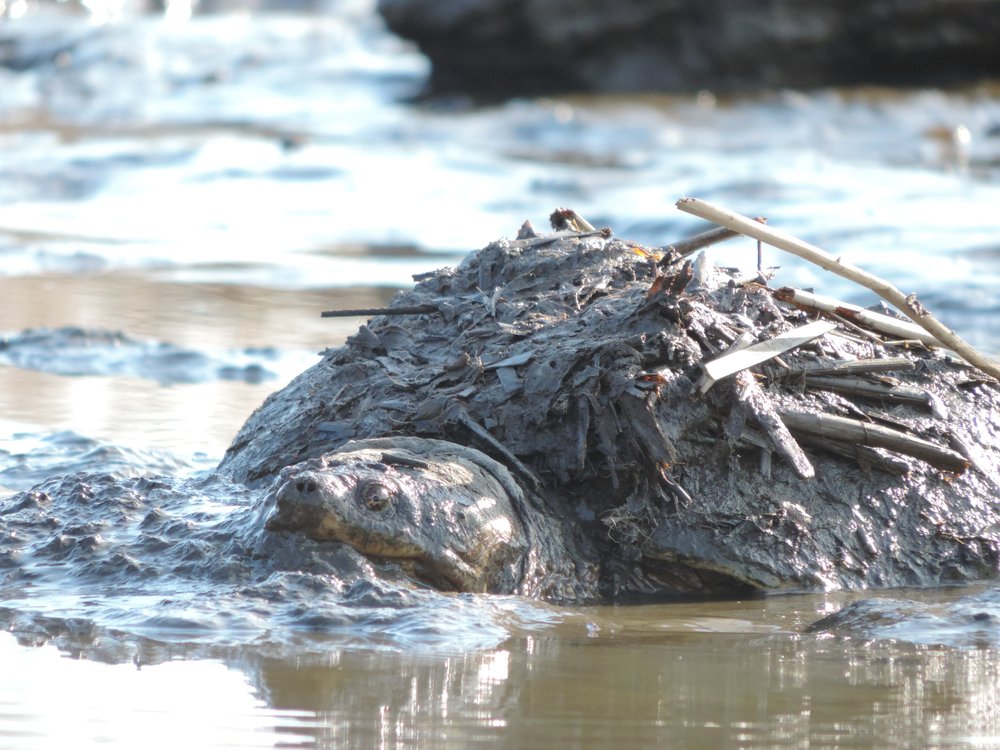Housekeeping
I’d like to think that people who eat Stone Blue chips (as I do) don’t throw the packaging overboard or out the window of a speeding car. But it seems they do. I picked up the wet and silt covered bag along with an empty Gatorade bottle, a plastic coffee container and other stuff that littered the Tivoli landing. The debris washed up on shore shook me and made it near impossible to get my boat into the water. I spent twenty minutes picking up trash before I could slide my kayak into the water on my first paddle of 2017.
In spring, snow melts and the roadsides are revealed for what they are: dumping grounds for people’s stuff. Some is overt, like the trash bag tossed that then bursts or is torn apart by a hungry raccoon. But most are items casually flung from a car window. I like to undertake a thought experiment: I picture myself sailing down the road in my Subaru and I toss a Ginger Ale can from the window. I can’t do it, even in my imagination.

I’d like to think that people who eat Stone Blue chips (as I do) don’t throw the packaging overboard or out the window of a speeding car. But it seems they do. I picked up the wet and silt covered bag along with an empty Gatorade bottle, a plastic coffee container and other stuff that littered the Tivoli landing. The debris washed up on shore shook me and made it near impossible to get my boat into the water. I spent twenty minutes picking up trash before I could slide my kayak into the water on my first paddle of 2017.
In spring, snow melts and the roadsides are revealed for what they are: dumping grounds for people’s stuff. Some is overt, like the trash bag tossed that then bursts or is torn apart by a hungry raccoon. But most are items casually flung from a car window. I like to undertake a thought experiment: I picture myself sailing down the road in my Subaru and I toss a Ginger Ale can from the window. I can’t do it, even in my imagination.
In the same way that our careless ways are revealed to us in the roadside so too does the river tell our dirty story. Stuff collects under the ice, in the snow that laces the edge of the river. Released, it travels about, along with logs and sticks, stumps that have floated free from land. There’s no other way to say it: yesterday the river was a chocolate mess.
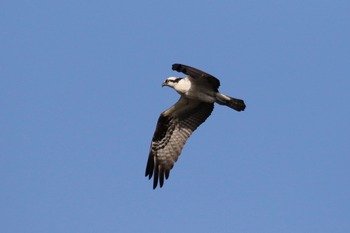
There’s something invigorating about this mess: I have something to do. It was Marjory Stoneman Douglas who wrote “It is a woman’s business to be interested in the environment,” she wrote. “It’s an extended form of housekeeping.” She wrote The Everglades: A River of Grassin the Rivers of America series, transforming the way people view this land from a treacherous miasmic swamp to a beautiful river of grass.
And I hate to say it, but in my case, she’s right: I love picking up garbage. One minute the shoreline is littered, then it is clean. My work is fast and obvious. In this political climate having that sense of small accomplishment seems essential, gives me energy to embark on the larger house cleaning issues.
As my friend Kate and I paddle the river south, past Magdalen Island, then Cruger and into the South Tivoli bay I see the Cormorants V-ing north along the river, I see the Osprey perched on the channel marker. I delight in the Green-winged Teal that flushes when we enter the Bay. But I also take note of the plastic barrel, the Styrofoam, the jugs and buckets bobbing about in the water, the logs that I must miss lest then flip me over.
I can’t wait to get out and sweep these things out of the river. And so I look forward to Riverkeeper Sweep, now in its 6th year. On May 6, thousands will take to the shoreline picking up trash. We’ll all be house keeping the earth. In Tivoli we’ll be tidying our shoreline. Come join us—surprise yourself with how satisfying a clean house is.
Kayaking the Arctic

In 1896 Nansen with his traveling companion Johansen end their three year expedition in the Arctic crossing open water in kayaks made of skins stretched over a wooden frame. The kayaks were boxy and stable and could carry a large load. At one point, walrus surround their boats, and a walrus “shot up beside [Nansen], threw itself onto the edge of the kayak, took hold farther over the deck with one fore-flipper and, as it tried to upset [him], aimed a blow at the kayak with its tusks.” At another point, a walrus punches a hole through his boat.

On my last day in Longyearbyen, in the Arctic, I wanted to kayak. In a kayak you sit close to the water, and I hoped to feel more inside of this landscape that we had been floating through on a sailboat for the past two weeks. But also, at home in the Hudson Valley I kayak every day, so to be in a little boat on the water for me is to feel home.
In 1896 Nansen with his traveling companion Johansen end their three year expedition in the Arctic crossing open water in kayaks made of skins stretched over a wooden frame. The kayaks were boxy and stable and could carry a large load. At one point, walrus surround their boats, and a walrus “shot up beside [Nansen], threw itself onto the edge of the kayak, took hold farther over the deck with one fore-flipper and, as it tried to upset [him], aimed a blow at the kayak with its tusks.” At another point, a walrus punches a hole through his boat.
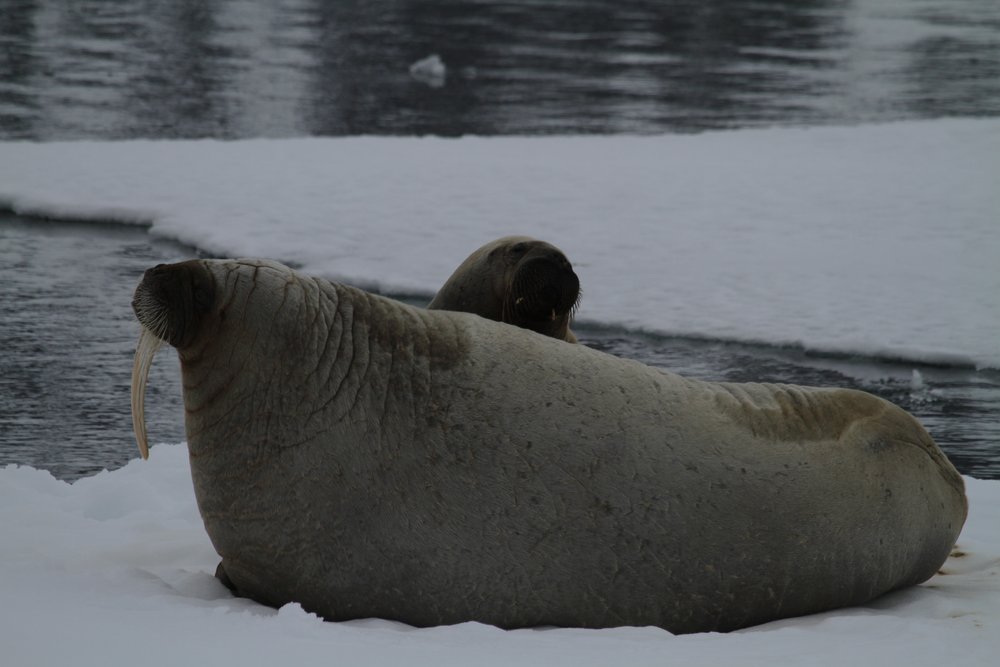
Imagine this walrus climbing onto your kayak...I think about paddling in my kayak and a walrus flopping onto the deck. I’d roll over in an instant. On our second day on board Antigua, someone thudded down the hallway and knocked on doors. “Walrus,” the call went out. Jolted from sleep, we emerged on deck to see a mother walrus with a baby lounging on a cake of ice. They both peered at the boat as we floated past. The baby lifted its head in curiosity and the mother took her large flipper and pushed it down. We were close enough to these big slug-like creatures to get a sense of the heft—and it made me dizzy to imagine such an animal sharing my kayak with me.
A few days later we saw a pile of walrus on land. They lay on their backs, tusks pointed toward the sky. They lolled on each other, and on the sand, fanning themselves with their flappers. Two remained in the water, playfully rising up in battle. The tusks are formidable, long, wide, hard. How fast it could gouge a boat!
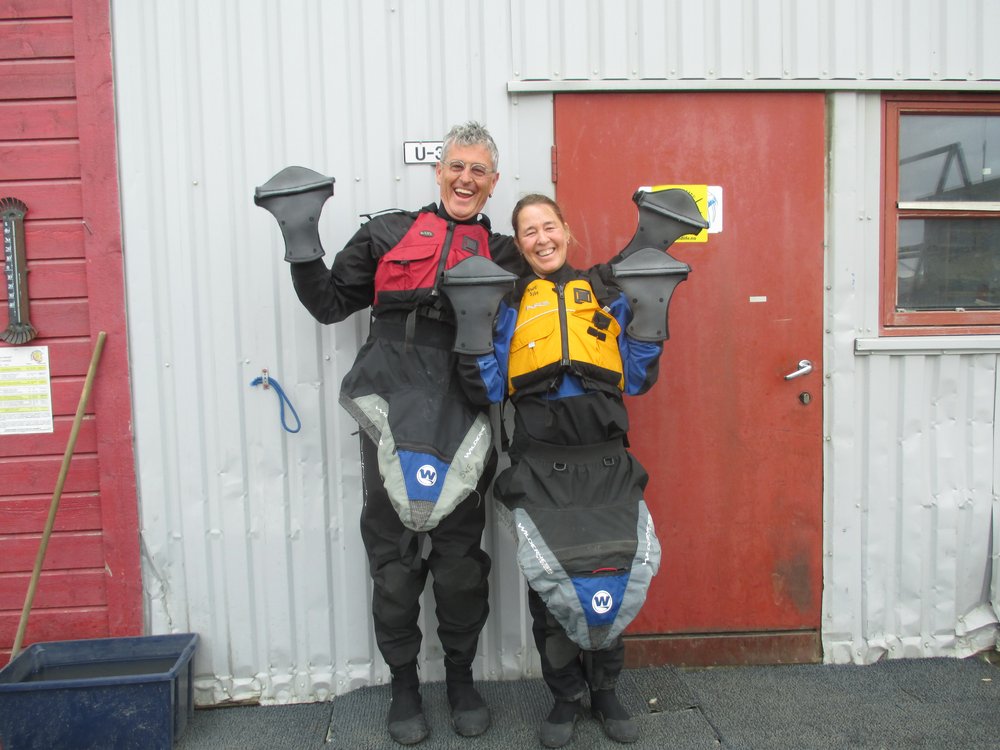
Cold water ready with Donald FortescueThe worst kayaking moment for Nansen, however, is when the kayaks—with all of their gear—float off. Without that gear they are dead men. Swimming to retrieve the boats, he could also have died. But the later option is the one he had to chose. Nansen vaults into the water and catches up to the boats.
I’ve had a boat float off without me, but swimming out into the Hudson is not swimming the Arctic. I had made three quick plunges into the icy water while I was in the North—three strokes was about all I could manage. I emerged breathing quickly, stunned by the cold. My body soon started to tingle, to vibrate with an ice cube vigor. It takes Nansen hours to warm himself.
It is for gripping scenes like this that I read these polar narratives, thrilling at the adventures. In some ways, I have spent my life trying to recreate that sense of adventure that comes with the unknown. And so certainly that was in my mind when I rented a kayak through Svalbard Wilderness Adventures and with fellow Arctic Circler Donald Fortescue headed out at 9 in the morning in dry suits, and full of instructions on the cold. We had one young Swedish guide and three other kayaks, all doubles (Donald and I were in singles). We shoved our boats into the Inisfjorden where Longyearbyen sits. The water was black-green and wind-ruffled. We flew across the Fjord and slid onto shore on the far side within forty five minutes. There a few cabins rested. Some of these rustic cabins were built (and refurbished) when coal was mined from the mountain above. Now these are summer cabins. “Norwegians like their summer cabins,” the young guide explained. And I thought: who doesn’t?
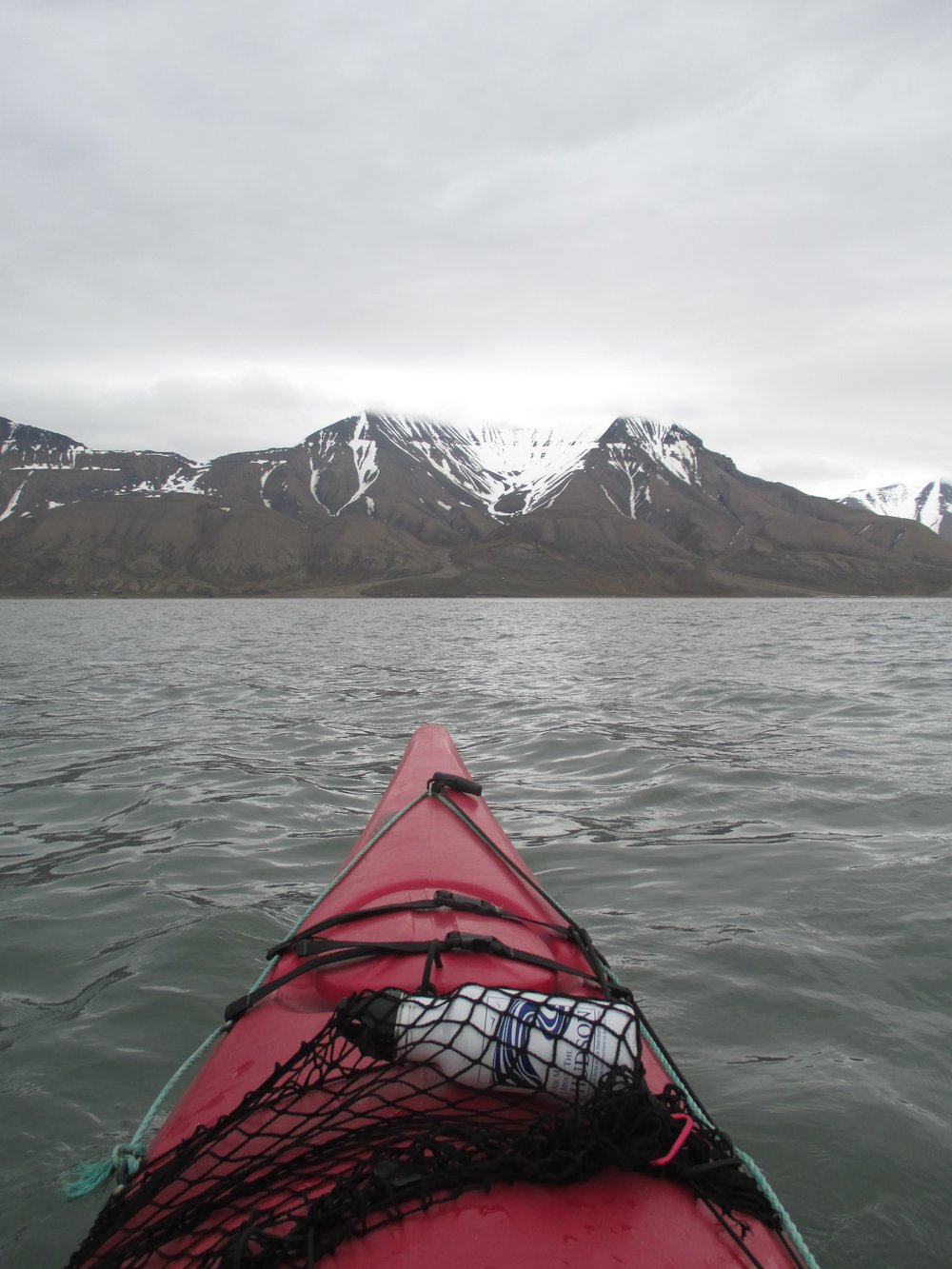
We built a fire and, wrapped in snowmobile suits, sat around shivering and eating a lunch of cheese and sausages. The Swedish boys regaled us with tales of driving the bad roads of Norway along the coast to Tromso in their Previa van. They would be road tripping back to Stockholm, looking for adventure that would probably come when their unreliable car broke down.
We walked the shoreline, enjoying a Purple Sandpiper along the beach line and the ever-present Arctic Terns. We looked at the remains of an airplane, wrecked on this lonesome shore.
The return felt like paddling across a wind-tossed Hudson River in early April, the water still snapping cold. We had no encounters with walrus or other creatures. We had no mishaps with the boats. It was an oddly tame paddle; this is what the guides guarantee. But something in me expected an adventure in this half tamed, cold land. But what I realized as my boat slid on to shore, my shoulders and arms pleasantly sore, that my outings alone, close to home, in the tame and populated Hudson Valley, are often full of more unexpected moments, mis-haps, those moments I’d call adventure.
Baby Beaver


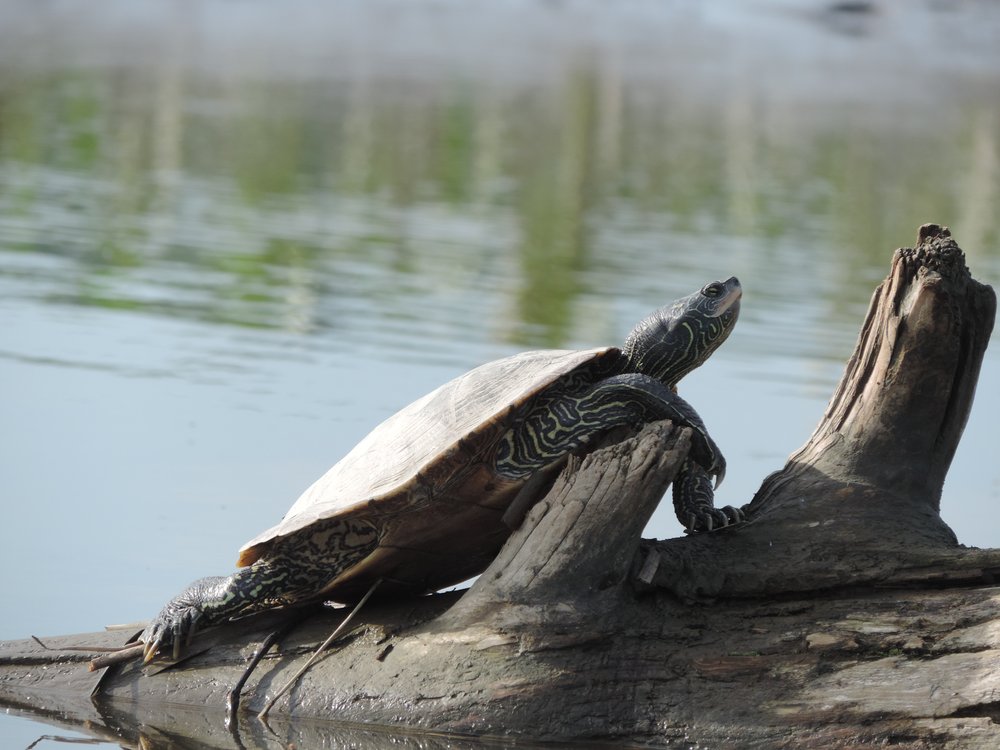
In the distance, I saw the tell-tale V of a beaver plowing through the water. In 1840, the beaver was a rare animal in New York State. Trapping had all but wiped out this large rodent, whose pelts were used for hats and coats. When trapping was finally prohibited in 1895, some claim there were but 10 left in the State. In the North Tivoli Bay, it is hard to believe this desperate history: I always see a beaver. Or rather, I hear a slap of a broad tail, signaling danger before the beaver dives below the surface.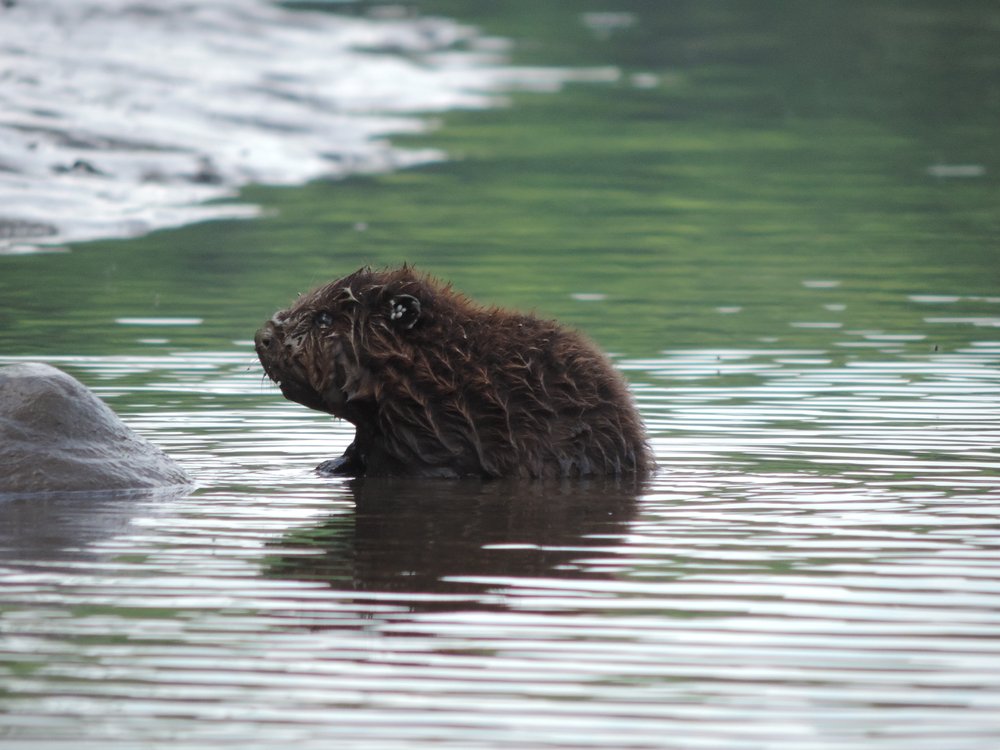
I guessed it was lost. Across the channel rested a stick pile, a beaver lodge. I moved my boat to the middle of the channel thinking the little beaver might swim to me once again and this would get it closer to home. It did. And I had the foresight to turn on the video in my pocket camera. And sure enough, after it rounded the stern of my boat, the baby beaver swam off toward the lodge. Watch the video here.
Full of optimism, I paddled home.
Back on the water, 2014
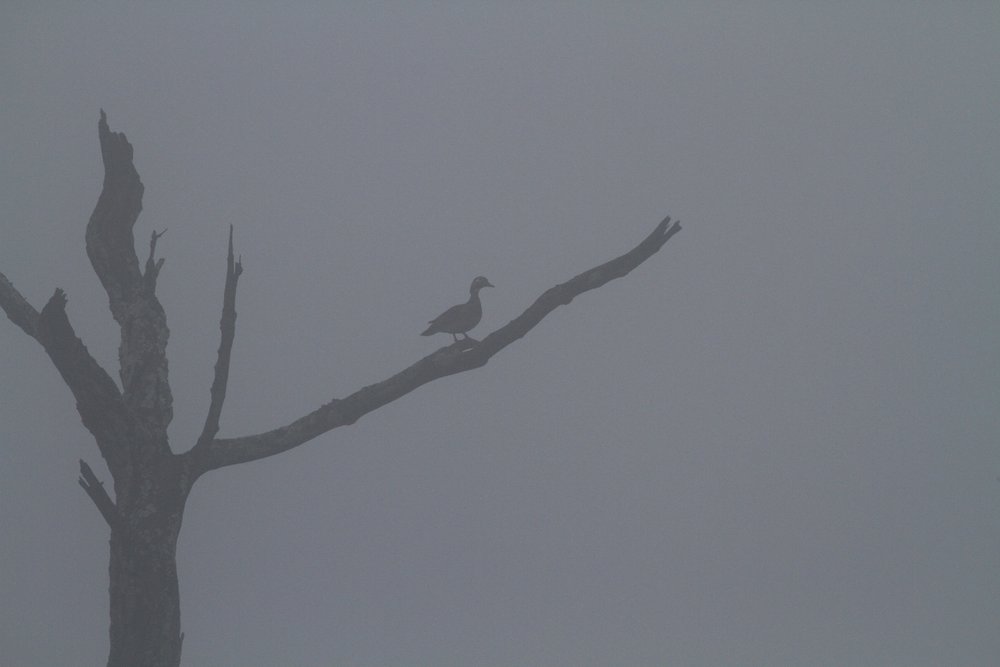
Four of us carted our kayaks down the wooden stairs at the North Tivoli Bay launch at noon. Sun, blue sky, a light breeze had taken over. We eased our wetsuit-cloaked bodies into our sleek boats and pushed off. It seemed so normal. And yet but two months ago we were walking this same spot on ice, hefting through snow that reached to our thighs. Now it was all liquid and freedom. To paddle out, under the railroad trestle onto the Hudson River, cold and brown, wide and empty. We skirted the eastern shore, trailing the rip rap, and the still bare trees; the wake of a tug and barge knocked us around a bit. Then we popped back into the bay through a southern passage.

Four of us carted our kayaks down the wooden stairs at the North Tivoli Bay launch at noon. Sun, blue sky, a light breeze had taken over. We eased our wetsuit-cloaked bodies into our sleek boats and pushed off. It seemed so normal. And yet but two months ago we were walking this same spot on ice, hefting through snow that reached to our thighs. Now it was all liquid and freedom. To paddle out, under the railroad trestle onto the Hudson River, cold and brown, wide and empty. We skirted the eastern shore, trailing the rip rap, and the still bare trees; the wake of a tug and barge knocked us around a bit. Then we popped back into the bay through a southern passage.
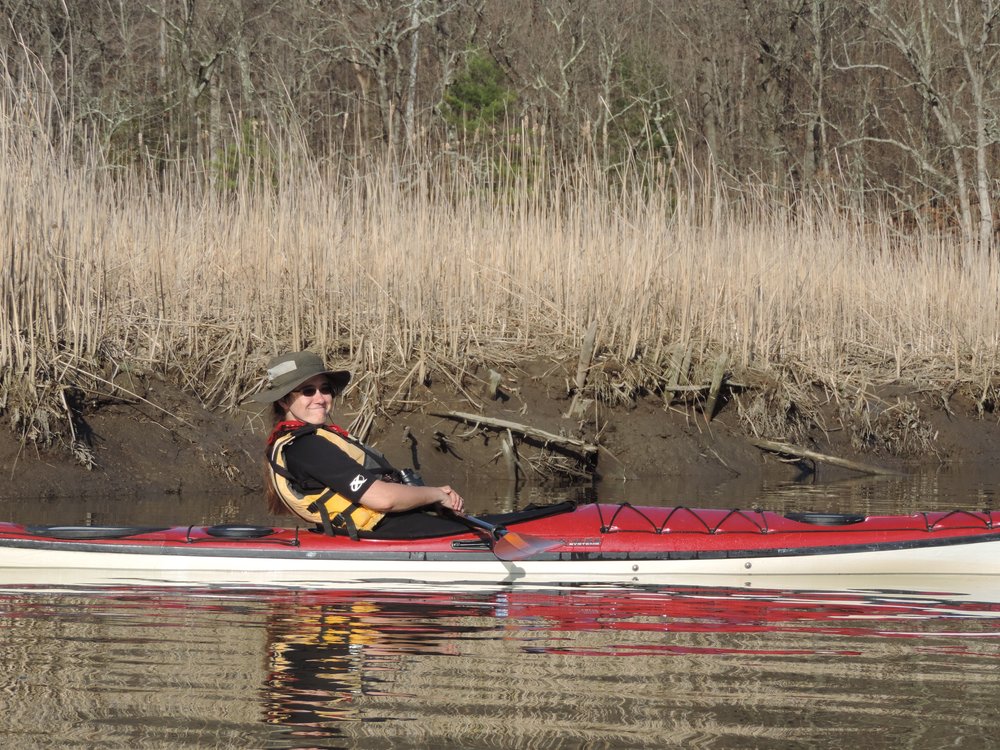
“Let’s see an osprey, a long tailed duck,” Christina said. "And a smew."
I nodded. The osprey was possible. As for the duck, less likely. I didn’t even know what a smew looked like but Christina had been clamoring for one for the past few weeks. (A smew is a dashing looking Eurasian black and white merganser, and a rare visitor to the western Aleutian islands of Alaska).
It is a treat to look for birds with someone more optimistic than I am. “Let’s go find that smew,” I said as we gathered to paddle across the river. The Hudson felt bare, exposed without green to rim the shoreline and boats purring north and south. We spied a few other kayaks but otherwise, it was us, the outgoing tide, and a few spring logs floating south.
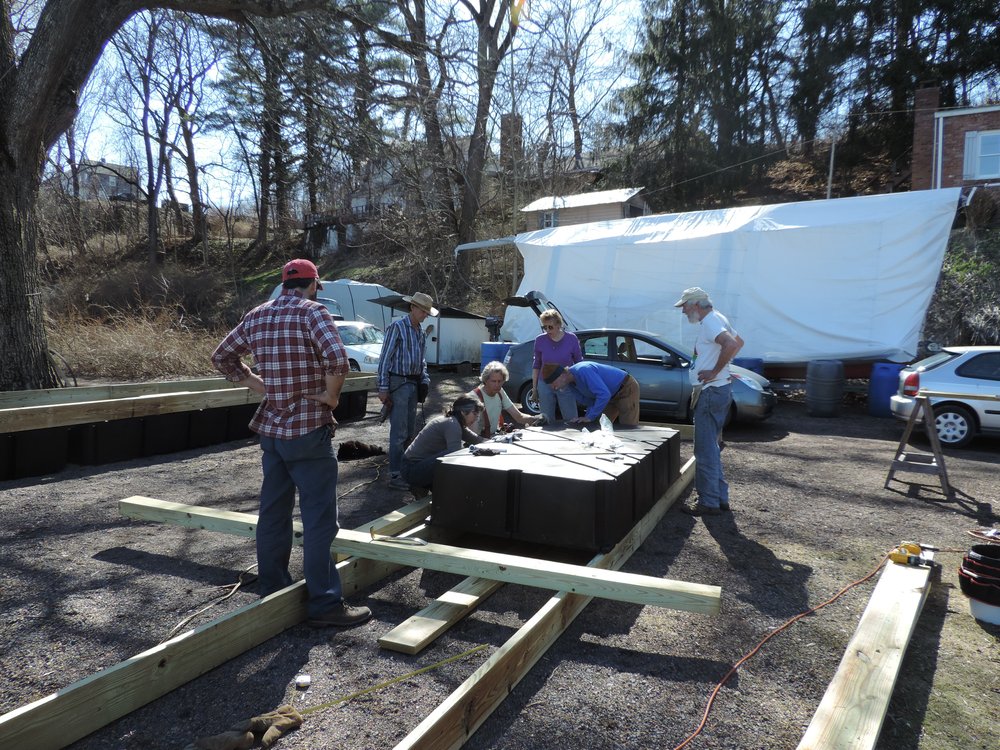
North, we found green-winged teal on the shoreline, a few common mergansers floating nearby and bufflehead out in deeper water. I looked up to see an osprey flying over, the crooked wings distinctive.
“There’s your osprey,” I called to Christina. Sometimes I believe that if you wish hard enough to see a bird, it will appear. Was the smew next? No, what was next, was a one boat parade coming from the south. The unbalanced, brightly colored ship is a replica of the Half Moon, the ship Henry Hudson sailed in 1609. When I think of Hudson I don’t usually have kind thoughts, but looking at this squat ship, I scrolled back to imagine the courage, perhaps folly it took to embark on these early voyages.
 “And remember, no gps system or maps, just the moon and stars and a sextant and vast oceans of doubt and wonder,” I said to my travel mates.
“And remember, no gps system or maps, just the moon and stars and a sextant and vast oceans of doubt and wonder,” I said to my travel mates.
Once back in the North Bay, tired and happy from the sun and the movement, we moved slowly, chasing two disgruntled Canada geese. A barred owl hooted from the woods, an early evening call. I spied a lump in the mud--it was now low tide. The shape was odd enough that I stopped to look. Sure enough, the mud lump had two eyes, nostrils. My first snapper of the season. Soon, it squished its head below the surface.
No smew, but a duck in the fog and a snapper in the mud. A river to paddle and friends to paddle with.

